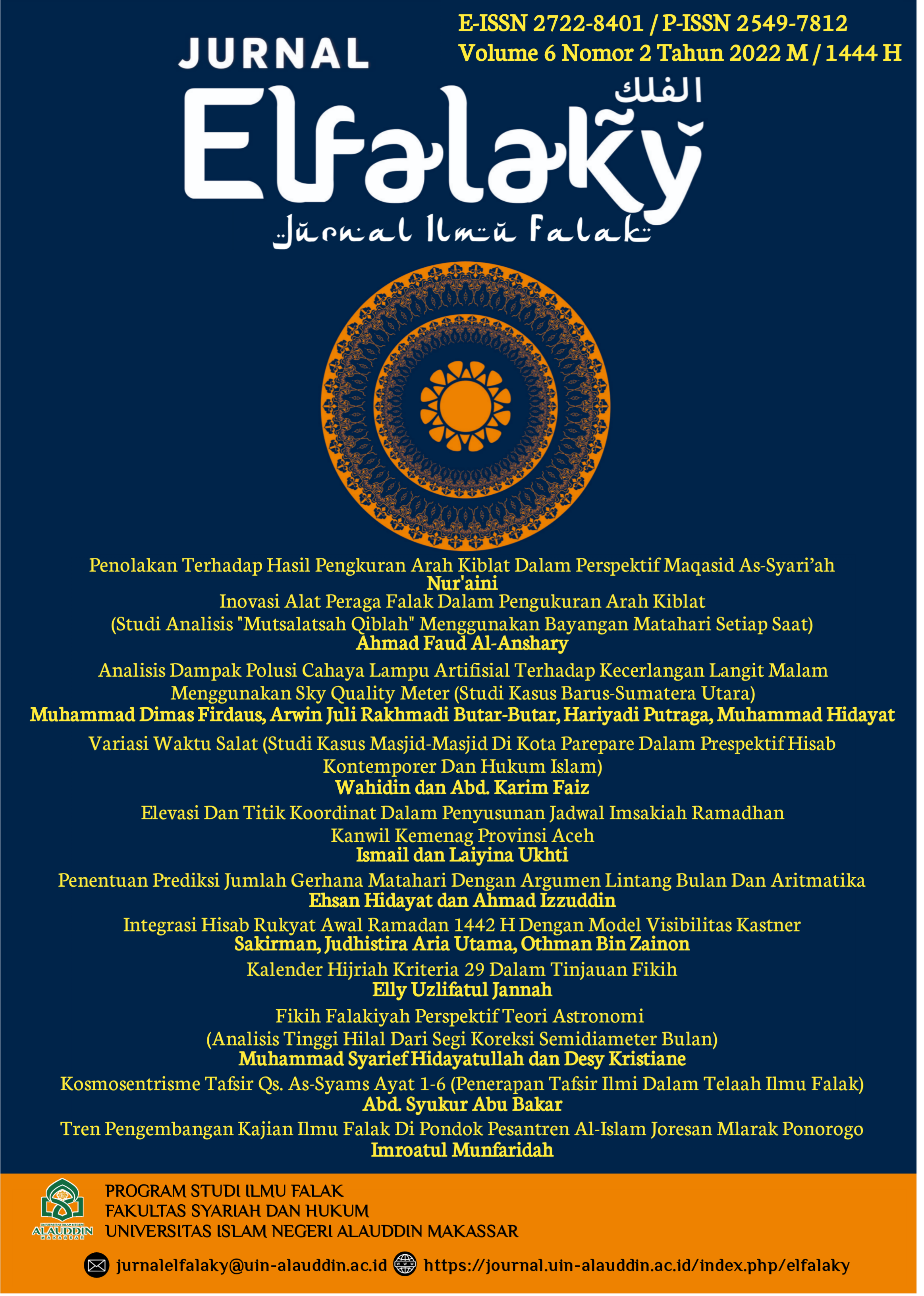INTEGRASI HISAB RUKYAT AWAL RAMADAN 1442 H DENGAN MODEL VISIBILITAS KASTNER
Abstract
There is no empirical evidence of the early hilal of Ramadan 1442 H that was observed through technological devices. The justification for witnessing the new moon still refers to the syar'i new moon term, not the astronomical new moon. The country of Brunei Darussalam can be used as an example when the astronomical hilal is not successfully observed, then the beginning of the hijri month is the next day or fulfills the ongoing month and there is no legal tolerance such as the use of the syar'i hilal term to replace the astronomical hilal. The integration of reckoning-rukyat is actually a methodological endeavor to perfect the criteria for the beginning of the Hijri month. Kastner's hilal visibility model is present in an effort to bridge the refinement of the criteria for the beginning of the hijri month. Through the criteria for the visibility of the hilal, Kastner offers a mathematical model that can be used as a role model for observing the hilal. Kastner's hilal visibility mathematical calculation model can be expressed in a curve that can be translated easily. Based on Kastner's hilal visibility, the early hilal of Ramadan 1442 H the hilal cannot be observed with the visual eye. Perukyat's testimony of seeing the hilal at the beginning of Ramadan 1442 H can be rejected by law because it is not based on empirical evidence in the form of a hilal image as a result of visual eye observation. According to Kasnter's hilal visibility model, the visibility of the hilal at the beginning of Ramadan 1442 H reached the maximum hilal visibility with a value of -1.68 for visual observations, the height of the hilal at the same time was 1.56 degrees (height difference between the Moon and the Sun at that time was 4, 46 degrees) with an elongation of 4.70 degrees. Observing the new moon without using tools such as a telescope, will not succeed in detecting the figure of the new moon, because the visibility of the new moon is still negative since sunset.
References
Admiranto, Agustinus Gunawan, Menjelajahi Bintang Galaksi dan Alam Semesta, Yogyakarta: Kanisius, 2009.
Arkanuddin, Mutoha dan Sudibyo, Muh. Ma’rufin, “Kriteria Visibilitas Hilal Rukyatul Hilal Indonesia (Konsep, Kriteria, dan Implementasi)”, Al-Marshad: Jurnal Astronomi Islam dan Ilmu-Ilmu Berkaitan, Volume 1 Nomor 1 Tahun 2015; Aris, Nur, Ṭulū’ Al-Hilāl, Rekonstruksi Konsep Dasar Hilāl, Al-Ahkam Jurnal Pemikiran Hukum Islam Volume 24 Nomor 2 Oktober 2014.
Badan Hisab dan Rukyat Departemen Agama, Almanak Hisab Ru’yat, Jakarta: Direktorat Bimbingan Masyarakat Islam Kementerian Agama RI, 2010.
Crumey, Andrew, “Human contrast threshold and astronomical visibility”, Department of Humanities, Northumbria University, Published by Oxford University Press on behalf of the Royal Astronomical Society, MNRAS 442, 2600–2619 (2014), doi:10.1093/mnras/stu992.
Departemen Agama RI, Hisab Rukyat dan Perbedaannya, Jakarta: Dirjen Binbaga Islam, 2004.
Djamaluddin, Thomas, Astronomi Memberi Solusi Penyatuan Umat, Jakarta: LAPAN, 2011
-------, “Re-evaluation of Hilaal Visibility in Indonesia”, http://www.icoproject.org/pdf/djamaluddin_2001_in.pdf diakses 14 April 2021.
Izzuddin, Ahmad, Fiqh Hisab Rukyat, Jakarta: Erlangga, 2007.
Raharto, Moedji, Kalender Islam: Sebuah Kebutuhan dan Harapan, Seminar Nasional Mencari Solusi Kriteria Visibilitas Hilal dan Penyatuan Kalender Islam dalam Perspektif Sains dan Syari‟ah, (Bandung: ITB 19 Desember 2009).
Raharto, Moedji, dkk., “New Approach On Study Of New Young Crescent (Hilal) Visibility And New Month Of Hijri Calendar”, UNNES Physics International Symposium 2018 (UPIS2018), IOP Conf. Series: Journal of Physics: Conf. Series 1170 (2019) 012080, doi:10.1088/1742-6596/1170/1/012080.
Anwar, Syamsul, Hari Raya & Problematika Hisab-Rukyat, (Yogyakarta: Suara Muhammadiyah, 2008).
Schaefer, Length of the Lunar Crescent, Q. Jl R. astr. Soc. 32, 265-277, 1991.
Sudibyo, Ma’rufins, “Mengenal Lebih Lanjut Kriteria Visibilitas Hilal Indonesia”, Makalah Prosiding Pertemuan Ilmiah XXV Himpunan Fisika Indonesia, Purwokerto, 9 April 2011.
Tuddar, Hasna, Redefinisi Hilal dalam Perspektif Fikih dan Astronomi, Al-Ahkam, Jurnal Pemikiran Hukum Islam, Volume 22 Nomor 1, 2012.
Utama, J. A., S. Siregar, “Usulan Kriteria Visibilitas Hilal di Indonesia dengan Model Kastner”, Jurnal Pendidikan Fisika Indonesia (2013), 197-205, Juli 2013.
Utama, Judhistira Aria dan Hilmansyah, “Penentuan Parameter Fisis Hilal Sebagai Usulan Kriteria Visibilitas di Wilayah Tropis”, Jurnal Fisika, Vol. 3 No. 2, Nopember 2013.
Utama, Judhistira Aria, “Kebersamaan dalam Beridul Fitri Karena Istikmal”, Harian Republika, diakses 14 April 2021.
http://www.icoproject.org/icop/ram42.html diakses 14 April 2021 diakses 14 April 2021
https://www.moonsighting.com diakses 14 April 2021





